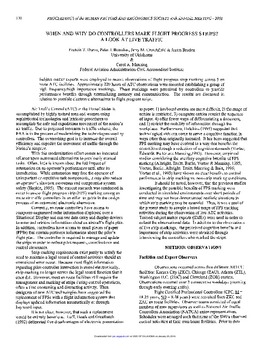| dc.contributor.author | Francis T. Durso | |
| dc.contributor.author | Peter J. Batsakes | |
| dc.contributor.author | Jerry M. Crutchfield | |
| dc.contributor.author | Justin Braden | |
| dc.contributor.author | Carol A. Manning | |
| dc.date.accessioned | 2016-01-14T19:53:45Z | |
| dc.date.accessioned | 2016-03-30T15:35:27Z | |
| dc.date.available | 2016-01-14T19:53:45Z | |
| dc.date.available | 2016-03-30T15:35:27Z | |
| dc.date.issued | 2001-10-01 | |
| dc.identifier.citation | Durso, F. T., Batsakes, P. J., Crutchfield, J. M., Braden, J., & Manning, C. A. (2001). When and Why Do Controllers Mark Flight Progress Strips? a Look at Live Traffic. Proceedings of the Human Factors and Ergonomics Society Annual Meeting, 45(2), 130-134. doi: 10.1177/154193120104500228 | en_US |
| dc.identifier.uri | https://hdl.handle.net/11244/25429 | |
| dc.description.abstract | Subject matter experts were employed to record observations of flight progress strip marking across 5 en route ATC facilities. Approximately 220 hours of ATC observations were recorded establishing a group of high frequency/high importance markings. These markings were perceived by controllers to provide performance benefits through externalizing memory and communication. The results are discussed in relation to possible electronic alternatives to flight progress strips. | en_US |
| dc.language.iso | en_US | en_US |
| dc.publisher | Proceedings of the Human Factors and Ergonomics Society Annual Meeting | |
| dc.title | When and Why Do Controllers Mark Flight Progress Strips? a Look at Live Traffic | en_US |
| dc.type | Research Article | en_US |
| dc.description.peerreview | Yes | en_US |
| dc.description.peerreviewnotes | https://us.sagepub.com/en-us/nam/manuscript-submission-guidelines | en_US |
| dc.identifier.doi | 10.1177/154193120104500228 | en_US |
| dc.rights.requestable | false | en_US |
